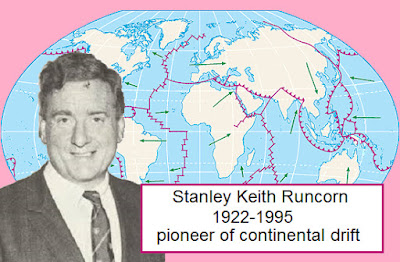Way back in March 2013
when my theme for the year was science and my “Ology of the Month” was geology
I wrote about the work of a gay geophysicist Allan Cox and his role in proving
the theory of continental drift. That validation wouldn’t have been possible
without the work of another gay geophysicist with whom he shared the Vetlesen
Prize (the “Nobel Prize” of the geological world) in 1971. The other recipient
was Stanley Keith Runcorn (1922-1995).
Here’s a quote about Keith
Runcorn (he was always known his second name) which shows how important he was
to geophysical research. It comes from the introduction to “Mantle Dynamics:
Treatise of Geophysics”, edited by David Bercovivi, who described Runcorn as “a
unique figure in that he was at the forefront of major discoveries in
palaeomagnetism that led to the modern theory of plate tectonics…”.
Stanley Keith Runcorn was
born in the industrial north west of England in 1922. For a man whose
professional career revolved around rocks it’s not surprising to learn that his
father was a monumental mason. Despite these humble origins he went on to study
at Cambridge University, where he was during most of World War II.
Runcorn’s work in the
field of geophysics and geomagnetism would eventually lead to an invitation
from NASA to help in their Galileo Orbiter project and their research into
interplanetary magnetic fields. He was even accepted an invitation to join the
Pontifical Academy of Sciences in 1981.
Runcorn never hid his
homosexuality but didn’t involve himself in gay rights. He travelled almost
constantly, researching and lecturing, attending conferences and accepting
academic positions around the world. His stamina was immense, as was needed in
his favourite leisure activity, rugby. He was an active president of the
Newcastle University rugby club when he was a professor there.
It was on one of his many
lecture trips that he met his death. In 1995 Runcorn was invited to speak at
the Scripps Institute of Oceanography in San Diego. One night he picked up a
professional kick-boxer and karate black belt in a bar and took him back to his
hotel room. The next morning his battered and strangled body was found in his
hotel bathroom by a maid. The kick-boxer was later arrested and found guilty of
murder.
Runcorn became interested
in geomagnetism in 1946 shortly after becoming a physics lecturer at Manchester
University, where he met fellow academic Alan Turing, the “Father of the
Computer”. He later moved to Cambridge University and in 1956 he was appointed
Professor of Physics at Newcastle University. He remained there until his
retirement in 1988.
It was known that rocks
retain their magnetic orientation as they cool, thus indicating the direction
of the magnetic North Pole at the rock’s formation. Runcorn and his colleagues
discovered some rocks had a reversed polarity to layers immediately above and
below them indicating that the magnetic North Pole was at the geographic South
Pole. Some of these rocks also showed the polarity pointing in different
directions, as if the magnetic North Pole itself had moved.
This movement of the North
Pole wasn’t a theory which all scientists accepted. At first Runcorn himself
didn’t accept that it indicated continental drift, only what is called apparent
polar wandering. He changed his mind when he moved from Cambridge to Newcastle
in 1956.
The continental drift
theory wasn’t universally accepted. It had developed from late Victorian
studies into earthquakes. The invention of the seismograph helped to prove that
shockwaves moved through the centre of the planet in several ways, and this led
to the realisation that Earth wasn’t a solid lump of rock but had a molten
interior and solid core. Once the scientific world got their heads around that
idea a new one emerged, or re-emerged. Sir Francis Bacon way back in the 17th
century noticed that the coastlines of West Africa and South America almost fit
together. He didn’t give any explanation or reason for this, but in 1915 Alfred
Wegener brought this “coincidence” back to the science world, with evidence
from fossils, to create the continental drift theory. As with other theories
like black holes, evolution and the sun-centred solar system, other scientists
laughed. It was the study of paleomagnetism in rocks, and the works of Keith
Runcorn and Allan Cox among others, which helped to prove Wegener was right.
Finally another quote.
This one was written in his own lifetime, in celebration of his 60th
birthday, and was published in “New Scientist” on 28th April 1983.
Peter J. Smith wrote, “Runcorn has probably made more original contributions to
more branches of the subject than any other geophysicist; but if history judges
his work on that basis alone, it will come up with an incomplete assessment.
For what would be missing would be the effect of his enthusiasm on others, in
ways not recorded in the formal literature. There is no one better at
persuading people to do things they might not otherwise have been inclined to do.
There is no one better at perceiving likely growth points in geophysics, at
getting the money to pursue them and at encouraging people to work on them. And
finally, there’s no one with a more impressive grasp of the whole field of
geophysics on Earth – or the Moon for that matter.”
It is Runcorn’s work in
interplanetary geophysics and for NASA which we will return to in the future in
a “Star Gayzing” article.


No comments:
Post a Comment